Sunday, April 15,
1956, will always be remembered as "C-Day" at WMAQ-TV. It was described
by Broadcasting-Telecasting magazine as "a daring breakthrough the black-and-white
curtain." At 4:15 PM, Robert W Sarnoff, then President of NBC, pushed a button
and ushered in a new era in television. Channel 5 became the world's first all-color
TV station as "Wide, Wide World" carried the event to 110 NBC-TV affiliated
stations across the country.
|
Right:
On "C" Day, WMAQ-TV Station Manager Jules Herbuveaux (right) was host
to Robert W. Sarnoff (left),then president of NBC, now president of RCA, and Chicago
Mayor Richard J. Daley.
|
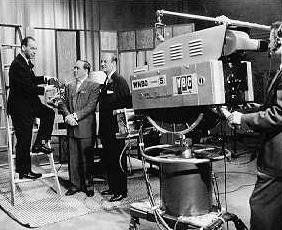 |
Brigadier General
David Sarnoff, Chairman of the Board of RCA and NBC, first announced the historic
event six months earlier. A closed-circuit news conference on November 3, 1955,
was held at the Merchandise Mart, and linked the press gathered there with reporters
at New York's Colonial Theater. It was carried in color.
WMAQ-TV provided light blue shirts for all male members of the press who attended
the Sarnoff news conference. In the early days of color, when intense lights were
used, white shirts or blouses caused a 'flaring' which transmitted to the picture
tube, distorting the color picture. Light blue shirts, however, showed up as white.
| Right: Burr
Tillstrom's Kukla, Fran and Ollie
were Channel 5's first regular daily program in color originated to the NBC-TV
network. |
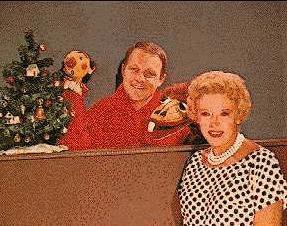 |
The color conversion
involvea five months of hard work. The project was under the general supervision
of Howard C. Luttgens, then Chief Engineer, and his assistant, W. C. "Bud"
Prather, who later became Station Manager of WMAQ-TV. Luttgens put a special task
force of 40 technicians through a "color college" involving around-the-clock
special training. The classes ranged from short sessions of several days for cameramen
to courses of several weeks for video and inaintenance engineers.
Other members of the staff were busy developing new color standards needed for
sets, wardrobe and makeup. Weatherman Clint Youle pondered about how to "color
the weather". He replaced his standard black marking pen with various colored
pens. On his weather map, movements of warm air would be traced with the traditionally
"hot" colors---red and orange.
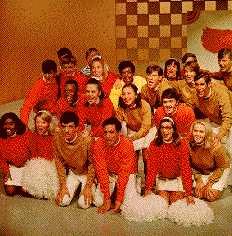 |
Left: "The
New Performers," Channel 5 prime time specials, present original musical-variety
shows featuring talented youngsters from Chicago area high schools. |
WMAQ-TV installed
its first color equipment in late 1953. Its first major color transmission was
the Rose Bowl parade of 1954 Channel 5's first local color program was John Ott's
"How Does Your Garden Grow?", featuring the use of timelapse color film.
It was introduced in March of 1955.
At that time, color required three times more lighting capability, and therefore
produced more heat---which, in turn, required additional air conditioning. Even
with the increased air conditioning, it was necessary to limit lighting during
rehearsals so that performers wouldn't appear on camera with perspiration rolling
down their faces.
| Right: The
set of "By Gemini", one of Channel 5's religious public service programs,
reflects the space age. The program appeals to children. |
 |
Channel 5's color
conversion project cost NBC more than $1,250,000. The advertising alone cost $175,000.
On "C-Day", three skywriting planes wheeled and dove over the city,
announcing the news in streamers of red, green and blue smoke.
 |
Left:
Teams of
bright young people from Chicago area high schools compete each week on Channel
5's "It's Academic"
intellectual quiz show.
|
A cartoon character
called "Tommy Tint" was developed for use in the station's advertising
and promotion campaign heralding "C-Day". Tommy appeared in newspaper
ads, billboards and on-the-air announcements. He even had a cocktail named for
him at the Merchants and Manufacturers Club in the Merchandise Mart.
| Right: Channel
5's 10 p.m. "NBC News:
Night Report" is Chicago's number one source for news (with Kalber and
O'Connor, of course). |
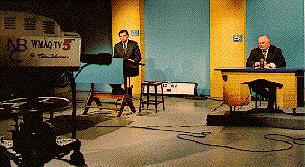 |
The Wall Street Journal
estimated that Chicago had about 50,000 color receivers in operation at the time
WMAQ-TV switched to all-color in April, 1956. At that time, the lowest price for
a color TV set was $595. By late 1968, there were nearly 865,000 color receivers
in the Chicago market, about 33 percent of the total number of sets.
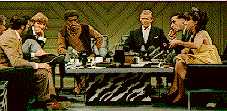 |
Left:
The Peabody
Award winning "Kup's Show" each week brings together top personalities
from all walks of life to revive the stimulating art of conversation.
|
At the outset, audiences
were given five to seven hours of color programming daily. This was later expanded
to about 10 hours. Included were all local live programs,
up to two hours of network shows and some film programs. |